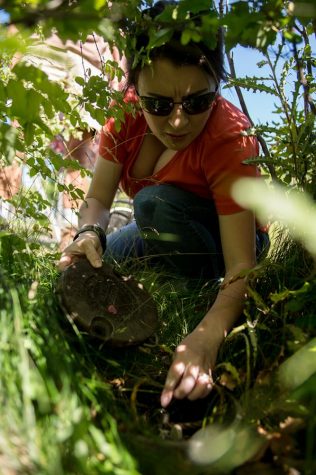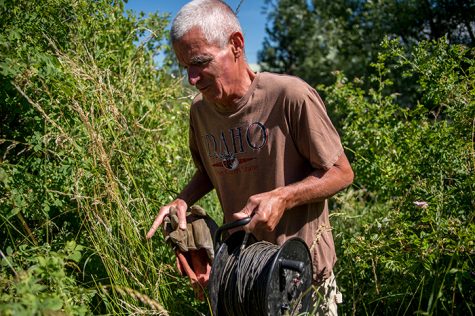Tracking local aquifer levels
As water supply drops each year, conservationists seek community involvement
July 5, 2017
In a grassy field on the University of Idaho campus, Steve Robischon pulls a 200-foot rope out of the ground and up to the surface. He is checking the ever-declining water level of the Wanapum Aquifer.
He takes out his notepad to mark the annual changes before heading to another well, one of many in Moscow and Pullman that researchers have used for years to log data about the Palouse Basin Aquifers, which are dropping about a foot each year.
Robischon is a long-time member of the Palouse Basin Aquifer Committee (PBAC), and he is training PBAC’s newest employee to take over his previous job as committee director.
Their next stop is a small creek with overgrown foliage lining the waterside. Korey Woodley, the new executive manager of PBAC, reaches through a cluster of bushes by the creek to unscrew the top of a well.

Korey Woodley places a data logger used to record water levels into a well Friday by the University of Idaho.
“A lot of people don’t understand what a foot a year really means,” she says.
Researchers don’t even understand what a foot a year means. They do not know when the aquifers will be empty or how many feet of water remain, Woodley says.
According to Pullman Operations Supervisor Blake Nylund, Pullman pumped 917 million gallons of water in 2016. That number is lower than in 2015, but the aquifer’s level is still declining at about the same rate.
The Grande Ronde Aquifer, which is the larger of the two aquifers, supplies drinking water to all Pullman residents.
Tyler Palmer, PBAC technical adviser and deputy director of operations in Moscow, says the decline is not the fault of any one person or business. Collectively, residents from around the Palouse area are using more water than the aquifers can produce.
PBAC’s goal is to inform the community of the water situation and to find a way to keep the aquifers at a stable level. Aquifers do recharge, but not quickly enough to keep from shrinking.
Palmer says people would have to stop taking showers to halt the falling water level.
“Even in best-case scenarios,” he says, “we can’t conserve our way out of our water issue.”
Anyone who runs their dishwasher, waters their lawn or washes their clothes uses water that originated from the aquifer, Palmer says.
PBAC is looking into tapping different water sources to balance aquifer use. They plan on suggesting ideas for alternative water sources such as using streams, storing extra water during wet periods, and creating local reservoirs on the Snake River or on creeks by Moscow Mountain, Palmer says.
This has to be a community decision, he says, and he and Woodley actively strive for community involvement. He says historically, people not helping with water conservation on the Palouse has been a problem.
“[Water] is not a sexy topic,” Palmer says, “but it’s probably the most critical thing we could talk about.”

Steve Robischon carries equipment back to his car after blazing his way through brush to get to a well.
Americans in general use a lot of water, he says, and they have habits the rest of the world does not. Other places, like Germany or third-world countries, understand that water is a resource, Palmer says.
Outdoor water usage takes a toll on the aquifers. For example, people have grown accustomed to their lawns being a deep green, he says.
“It’s just a weed that came into vogue at some point,” Palmer says, adding that deep green, lush grass takes a lot of maintenance and water. Ultimately, Palmer says, people’s perception of water needs to change.
“Water doesn’t bleed, but it should,” he says. “It’s one of those things that we take for granted.”
Correction: This article has been revised to reflect that Pullman pumped 917 million gallons of water in 2016, not 917 gallons.





















